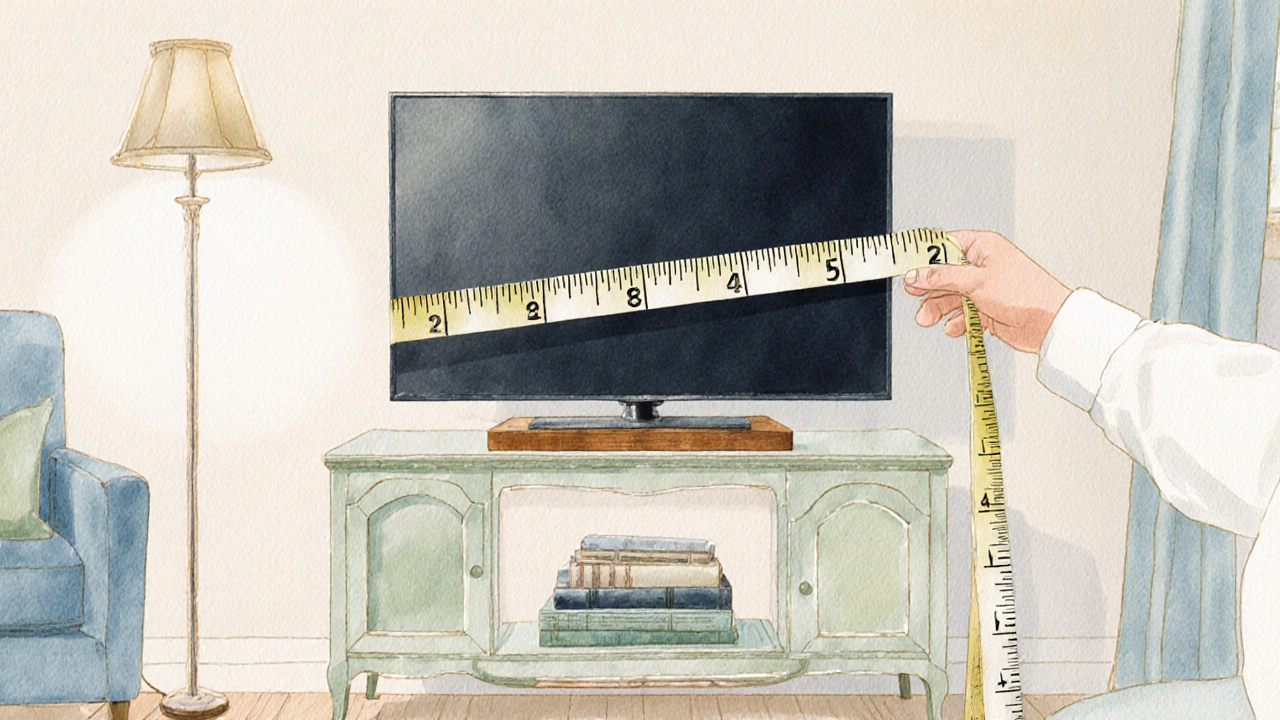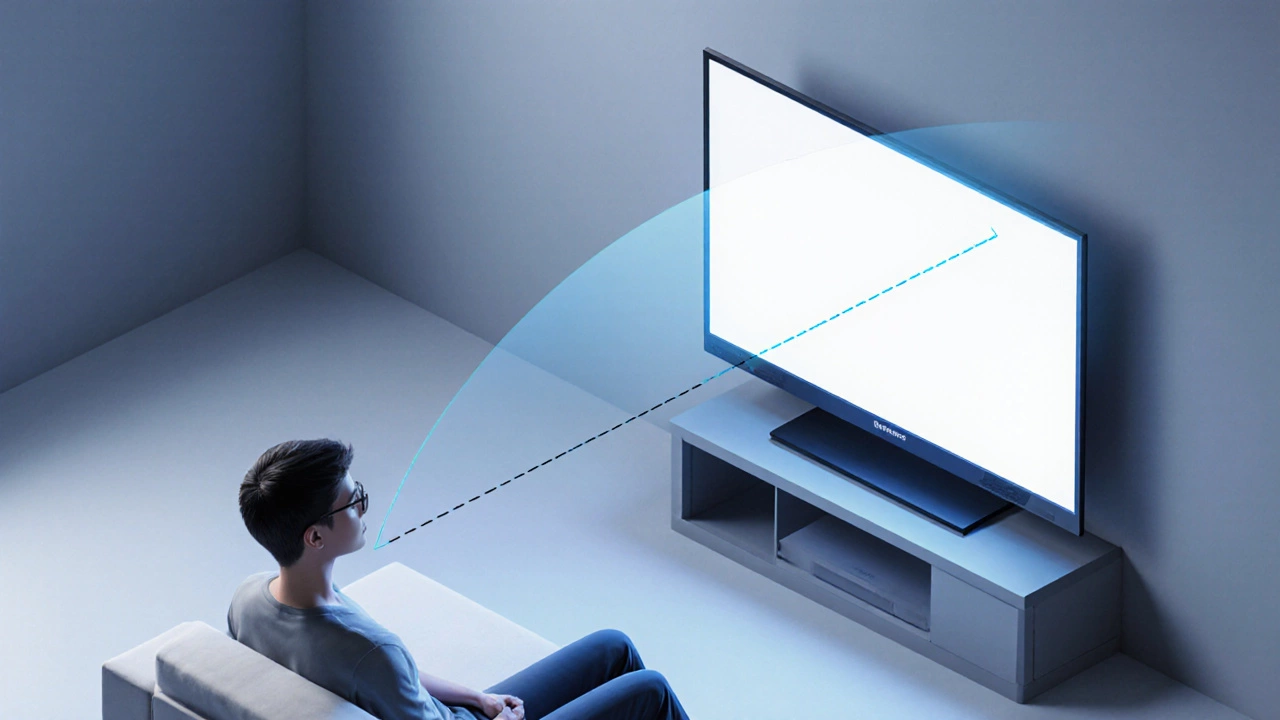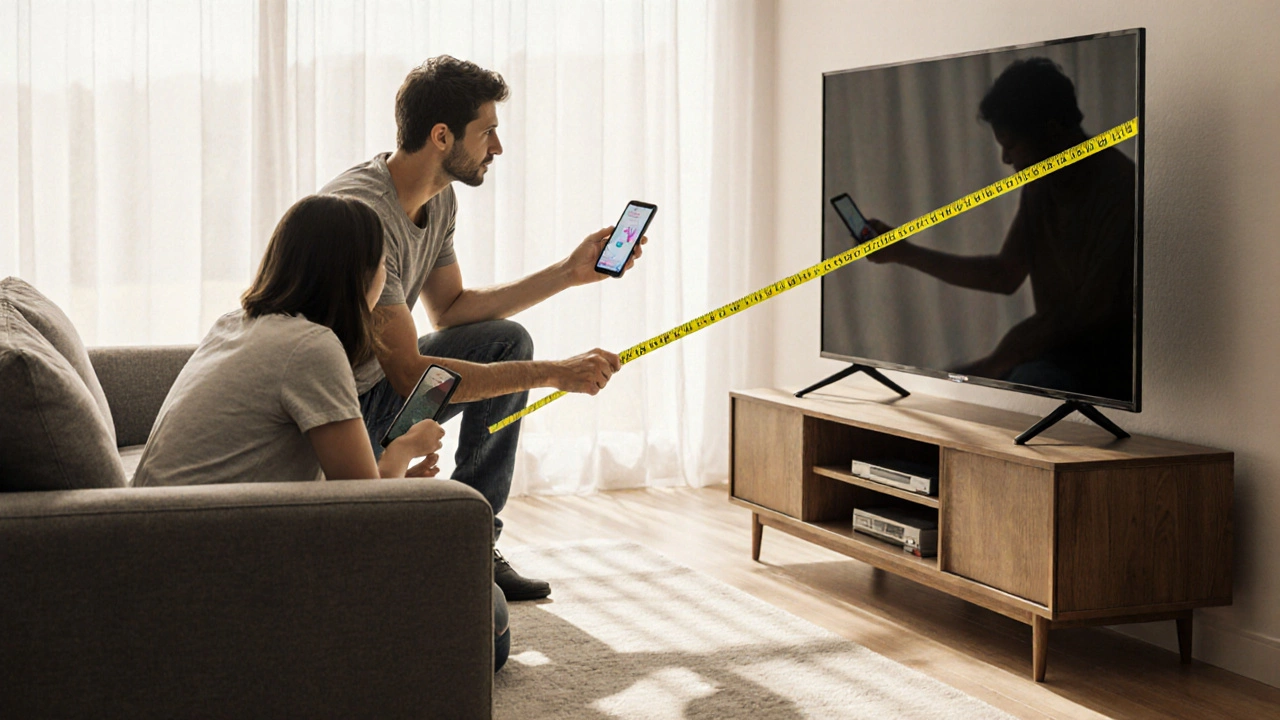TV Height Calculator
Enter Your Measurements
Ergonomic Results
Ideal Center Height Range
42 - 48 inches from floor
Your Calculated Center Height
0 inches
Recommended Stand Height
0 inches
Tip: For most viewers, keeping the TV center at eye level (42-48 inches) minimizes neck strain.
Key Takeaways
- Place the TV so its center is roughly at eye level when seated (about 42-48 inches from the floor for most adults).
- Adjust height based on sofa seat height, viewing distance, and screen size.
- Keep the vertical viewing angle within 15° above or below eye line to avoid neck strain.
- Use a simple formula - TV center height ≈ seat height + 1/2 of the screen’s diagonal - as a quick starting point.
- Fine‑tune with a tape measure and a friend’s help; small tweaks make a big difference.
Finding the sweet spot for your television isn’t just about aesthetics; it’s about comfort, health, and picture quality. Below we break down the science, the math, and the practical steps you need to set your TV at the right height on a TV stand.
Understanding the Core Entities
Before diving into numbers, let’s define the main players that shape TV placement.
Television (TV) is the display device that delivers video content to viewers, typically measured by diagonal screen size.
TV stand is a piece of furniture designed to hold a TV at a convenient height and often includes storage for accessories.
Eye level is the horizontal line extending from a viewer’s eyes when they are seated upright.
Viewing angle is the angle between the viewer’s eye line and the top or bottom edge of the screen.
Seating height is the distance from the floor to the top of the seat cushion, usually measured in inches.
Ergonomics is the study of how people interact with objects to minimize strain and maximize comfort.
Neck strain is muscle discomfort that occurs when the head is held at an unnatural angle for extended periods.
Screen size is the diagonal measurement of the TV panel, influencing both viewing distance and ideal height.
Viewing distance is the space between the viewer’s eyes and the screen, typically recommended as 1.5-2.5 times the screen diagonal.
Why Height Matters: The Ergonomic Angle
When the TV sits too low, you’ll tilt your head up, stressing the neck extensor muscles. Too high, and you’ll look down, compressing the cervical spine. Both scenarios can cause neck strain after a few hours of binge‑watching. Research from the University of Leeds (2023) showed that a vertical viewing angle beyond 15° leads to a 30% increase in perceived discomfort.
The goal, therefore, is to keep the vertical viewing angle within a comfortable range - ideally between 0° (eye level) and 15° above eye level. This range allows the eyes to remain level, reduces eye fatigue, and preserves the TV’s ideal picture geometry.

Quick Math: Estimating the Perfect Center Height
Use this handy rule of thumb to get a starting point:
- Measure your seating height (from floor to the top of the cushion). Typical sofas sit at 16-18 inches (40-45cm); armchairs may be 20-22 inches (50-55cm).
- Take the TV’s diagonal size in inches and divide by 2.
- Add the result to the seating height.
**Center Height ≈ Seating Height + (Screen Diagonal ÷ 2)**
Example: A 55‑inch TV on a sofa that’s 17inches tall gives:
Center Height ≈ 17 + (55 ÷ 2) = 17 + 27.5 = 44.5inches from the floor.
That places the TV’s midpoint right in the sweet spot for most adults.
Fine‑Tuning with Real‑World Variables
Numbers give you a baseline, but you’ll need to adjust for three common factors:
- Viewing distance: If you sit very close (less than 1.5×diagonal), bring the TV a bit lower to keep the top edge within the 15° limit.
- Screen shape: Ultra‑wide (21:9) displays have a taller vertical field; you may want the center slightly higher to avoid hitting the top‑edge limit.
- Multiple viewers: If you often watch with kids or guests on a lower couch, compromise by positioning the TV a touch lower than the strict formula.
After setting the stand, sit in your normal viewing spot and ask a friend to check the angle with a smartphone inclinometer app. Aim for a reading between 0° and 15°.
Choosing the Right TV Stand Height
A TV stand’s own height matters. Most ready‑made stands range from 20 to 30inches (51-76cm). To meet the calculated center height, you may need a stand with an adjustable shelf or a custom riser.
Here’s a quick compatibility chart:
| Seat Height (in) | Screen Size (in) | Ideal TV Center Height (in) | Suggested Stand Height (in) |
|---|---|---|---|
| 16‑18 | 40‑45 | 38‑44 | 20‑24 |
| 16‑18 | 55‑65 | 44‑50 | 24‑28 |
| 20‑22 | 40‑45 | 41‑47 | 22‑26 |
| 20‑22 | 55‑65 | 47‑53 | 26‑30 |
If you already own a stand that’s too low, add a sturdy riser or a set of decorative books to reach the target height. Just make sure the total height stays within the TV’s weight rating.
Practical Installation Steps
- Gather tools: tape measure, level, pencil, and a friend to hold the TV.
- Measure your seating height and calculate the center height using the formula above.
- Check the existing stand height. If it’s lower than the needed center height, stack a riser or choose a taller stand.
- Place the TV on the stand, center it left‑to‑right, and use a level to ensure it’s perfectly horizontal.
- Sit down, look straight ahead, and ask your helper to read the vertical angle with a smartphone inclinometer. Adjust up or down in ½‑inch increments until the angle reads between 0° and 15°.
- Secure cables, hide them with a cord cover, and double‑check that the TV is stable.
All done! Now you can enjoy movies without wobbling your neck.

Common Mistakes & How to Avoid Them
- Relying solely on TV size: A large screen on a low sofa will push the center too high. Always factor in seat height.
- Ignoring multiple viewers: If a child watches from a low beanbag, the TV may feel too high for them. Consider a slight compromise or a secondary lower screen.
- Using an unstable riser: Cheap plastic stands can wobble. Opt for solid wood or metal risers that match the TV’s weight.
- Forgetting cable management: A cluttered back can pull the TV forward, altering the angle over time.
When to Consider Wall‑Mounting Instead
If your stand can’t reach the ideal height or you want a cleaner look, a wall mount offers more flexibility. The same eye‑level rule applies, but you’ll also need to account for mounting height and stud placement. A tilt‑mount can help keep the TV lower while still providing a comfortable viewing angle.
Frequently Asked Questions
What is the ideal TV height for a 42‑inch TV on a standard sofa?
For a sofa seat height of around 17inches, the TV’s center should be about 38‑42inches from the floor. That usually means a stand around 20‑24inches tall.
Can I place the TV higher if I mostly watch from a recliner?
Yes. Recliners are often 22‑24inches high, so add about half the screen diagonal to that number. A 55‑inch TV would land around 50‑55inches from the floor, staying within the 15° viewing angle range.
Is a 15° viewing angle really that important?
Studies show that angles above 15° increase neck muscle activity and eye fatigue. Keeping the angle lower maintains comfort during long sessions like movie marathons.
What if my TV stand is already at the perfect height but the TV is still too high?
Adjust the TV’s tilt if the stand has that feature, or use a low‑profile stand with an adjustable shelf to bring the screen down a few centimeters.
Should I consider the TV’s bezel thickness when measuring height?
Yes. Modern TVs often have thin bezels, but the measurement should be taken to the very center of the screen, not the outer edge of the frame.
Next Steps & Troubleshooting
If after following the steps you still feel discomfort, try these quick checks:
- Re‑measure eye level: Use a ruler from the floor to your eye line while seated; small variations can shift the ideal height.
- Check couch cushions: Fluffier cushions raise the eye line; a firm seat lowers it.
- Re‑evaluate viewing distance: Sitting too close forces you to look up, so move back a bit and re‑measure.
Adjust incrementally-½‑inch changes can make a noticeable difference. Once you hit the comfort sweet spot, lock the TV in place and enjoy your shows without a sore neck.


Write a comment